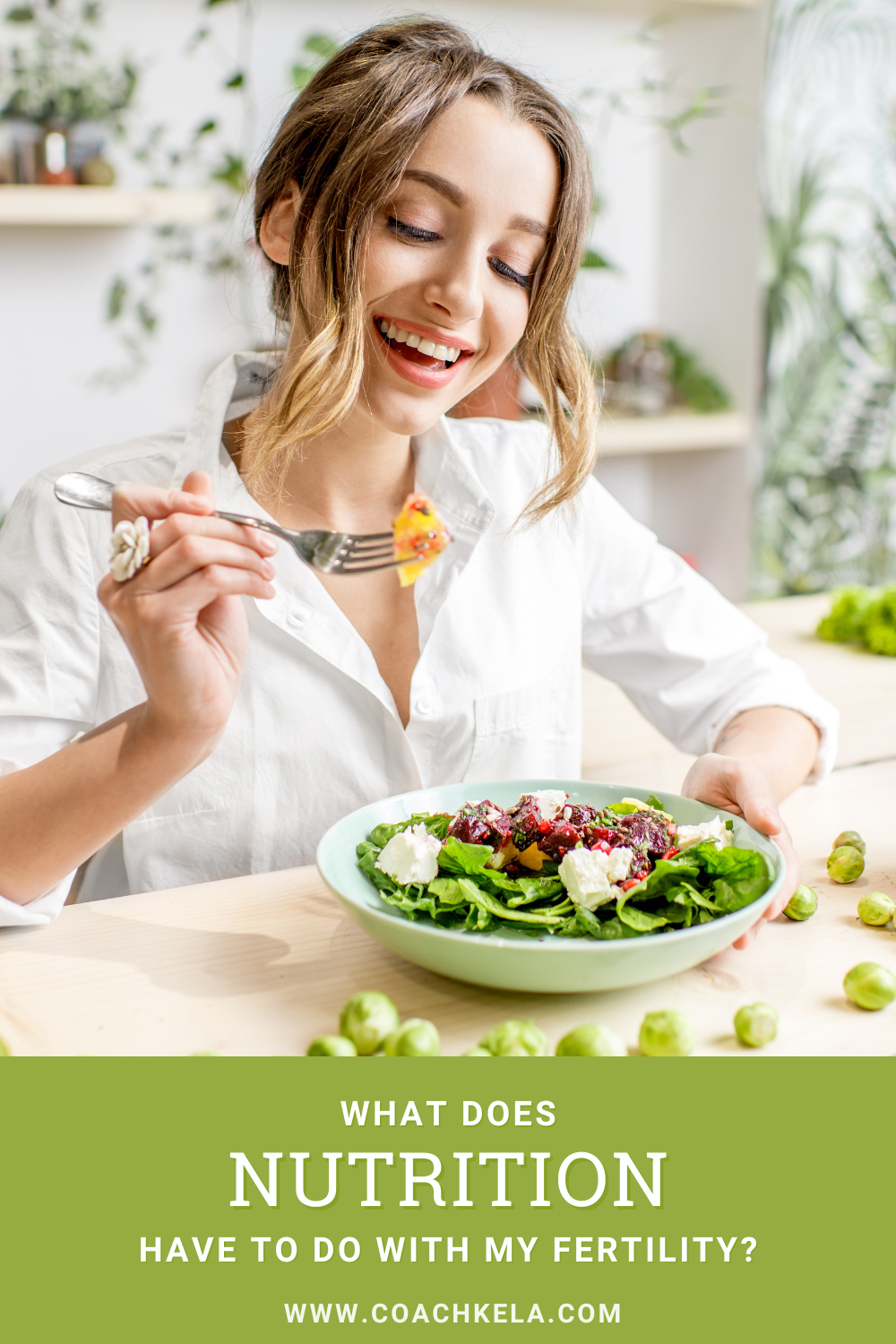Written by Guest Blogger: Olivia Neely, a Functional Fertility Dietitian.
According to the National Institutes of Health, cases of infertility between couples are pretty evenly split: about ⅓ of cases are caused by male factors, ⅓ by female factors, and ⅓ by both male and female factors.(1) While prenatal nutrition is often aimed at women, who are given the amazing job of preparing their bodies for pregnancy and nourishing sweet little baby in the womb, male partners can also benefit from souping up their nutrition to improve their sperm quality. Healthy dad, healthy sperm!
So don’t take on this burden alone! Optimizing fertility is a two-partner job! The advice below applies to you and your partner!
Does Nutrition Really Impact My Fertility?
Yes! Mom’s nutrition not only impacts the health of future baby while in utero, but mom and dad’s nutrition influences several aspects of fertility, from the quality of the egg and sperm to the amount of sperm produced to the thickness of the uterine wall.(2-10) Sperm health can even contribute to a woman’s likelihood of miscarriage. Taking multivitamins or prenatal vitamins is a great start, but let’s take a deeper dive into what you really need to boost you and your partner’s combined fertility and why.
Both egg and sperm are highly sensitive to oxidative stress, a form of cellular damage that occurs as a result of a

number of lifestyle factors, such as smoking, drinking alcohol, or eating a nutrient-poor diet. If you think of the egg and sperm as a classroom, oxidative stress would be unsupervised kindergarteners wreaking havoc wherever they play. Antioxidants, then, are our patient and hardworking teachers, stopping our children from drawing on walls and eating paste. If you are eating a nutrient-poor diet, your classroom is understaffed.
Omega-3s
The powerhouse of fertility fats, omega-3 fatty acids are a type of unsaturated fat that reduce inflammation by counteracting inflammatory omega-6s. Omega-6 fatty acids generally come from vegetable oil, and unfortunately, our Western diet is heavy in omega-6s and light in omega-3s. By reducing inflammation, omega-3s reduce oxidative damage, keeping our classroom nice and tidy.
However, omega-6s are not necessarily bad guys! We need them to help regulate metabolism, maintain bone health, and keep cholesterol in check, and they can also be converted into anti-inflammatory molecules. We run into trouble when our ratio of omega-3s to omega-6s is out of whack. Instead of reducing your omega-6 consumption, the American Heart Association recommends increasing your omega-3 consumption.(11)
DHA and EPA are the two most beneficial omega-3s for fertility and pregnancy. Not only are they needed for the development of baby’s brain, eyes, immune system, and nervous system, but they improve blood flow to the uterus and are associated with improved embryo implantation and sperm morphology.(12-13)
So, increase your omega-3 consumption by eating wild caught (when possible), fatty, cold-water fish 2-4x per week. This includes salmon, Atlantic mackerel, anchovies, herring, freshwater trout, and bluefin tuna. Limit high-mercury fish like swordfish, tilefish, bigeye (ahi) and albacore tuna, and king mackerel to once or twice per month.(14) If you’re not a fan of fish, you can also increase your omega-3s by eating flaxseed, chia seeds, and walnuts, though you’ll need to supplement with fish oil since these sources have much smaller quantities.
Vitamins Galore!
Basically, vitamins are organic substances that our bodies need in order to function properly. They are essential, meaning we can’t synthesize them ourselves, so we have to obtain them through our diet. Vitamins play a number of roles in our bodies, from helping enzymes do their jobs, to regulating body processes like metabolism, blood pressure, and methylation, to supporting our immune system and regulating hormones. If you aren’t getting enough vitamins, your classroom is understaffed.
The most effective way to increase your vitamin intake is to start by assessing your diet. Supplements are awesome tools to boost your intake and ensure you’re receiving adequate amounts, but, as their name implies, they’re supplemental! Our bodies didn’t evolve to consume vitamins as isolated pieces, but as tiny parts within whole foods. There is still so much we don’t know about the interplay of nutrients in our bodies, that opting for a pill over a veggie is just downright silly. Eat the broccoli. Your body and your baby will thank you.
Take a deeper dive into the role of vitamins in our bodies by checking out my previous post, Forgotten Fertility Nutrients.
Balanced Macronutrients
Embrace good food! Eat carbs! Eat fats! If you needed a sign to stop following your restrictive diet, this is it! I know that can sound scary for some of you, but restrictive diets can send a stress signal to your body that puts it in “no place for baby” mode. Optimal fertility requires a balance of what we call MACROtrio – fats, carbohydrates, and protein – to balance blood sugar, reduce oxidative stress on the ovaries, and improve hormone imbalances in men and women. It takes a lot of nutrients to fuel your fertility, so think of every meal as a chance to do just that!
Fertility Fats
Fats are not your enemy! In fact, if you are skimping on fertility fats then you may not be absorbing nutrients like fat-soluble vitamins from other foods you are eating (read: butter on broccoli is healthier than just plain steamed broccoli) and can be short-circuiting the creation of hormones like estrogen and progesterone. We need fats not just for hormone synthesis and nutrient absorption, but for organ protection, tissue structure, nerve impulse transmission, joint movement, and so much more. It’s almost like mother nature doesn’t want us to go on a low-fat diet?
That being said, certain fats definitely fuel your fertility better than others. Unsaturated fats like those found in avocados, nuts, seeds, vegetable oils, and fish help reduce inflammation (clean and tidy classroom!) and protect cardiovascular health, and are associated with healthier pregnancy outcomes compared to saturated and trans-fats.(15) These are the fats you want to fill up on first.
Saturated fats primarily come from animal sources, but you’ll also find high amounts in coconuts and palm oil. For decades, researchers linked high intakes of saturated fat with increased risk for heart disease, but recent research suggests this connection might not be as linear as it once seemed. What’s this mean for your fertility? Enjoy saturated fats in moderation. If you do decide to cut back on your saturated fat intake, replace those fats with unsaturated fats, not carbs. Some low-fat products may have less saturated fat than their full-fat counterparts, but they may be sneaking in more added sugar or additives to keep the same flavor or texture. So instead of swapping whole milk for almond milk in your Starbucks latte (which reduces protein and increases added sugar), maybe sub olive oil for butter when you’re cooking or choose lean meats like chicken, turkey, or fish.
Fats are not your enemy…but trans-fats? They are your enemy. While trace amounts of trans-fats can be found in some meat and dairy products, the vast majority of trans-fat comes in the form of partially hydrogenated oil added to food products to make them more shelf-stable. Trans-fats have been shown to increase the risk for high cholesterol, heart disease, type II diabetes, and stroke, and they create systemic inflammation.(16) In terms of fertility, trans-fats have been shown to reduce sperm count, sperm concentration, and semen quality, and they drastically increase the risk of anovulatory periods.(17) Thankfully, the FDA banned food manufacturers from adding trans-fats to their products effective January 2021, so if you live in the US, you’re officially in the clear. Woohoo!

Colorful Carbohydrates
Eat the rainbow! And no, I don’t mean load up on Skittles. Most colorful and phytonutrient-rich foods are carbohydrates like fruits and veggies, which makes them an essential part of a fertility diet. Phytonutrients have beneficial properties that reduce inflammation, protect our tissues from oxidative stress, help boost our immune system, and nourish our friendly gut bacteria. Carbohydrates are also our bodies’ preferred source of fuel, and too few carbs can leave us feeling sluggish and weak. Aim for two brightly colored foods at most meals, or about 4-6+ servings of fruits and veggies daily. Combinations could look like:
- ½ sweet potato + a heaping portion of asparagus with dinner
- a salad with red cabbage for lunch + ⅓ grapefruit to end on a sweet note
- sautéed spinach with your eggs in the morning + a handful of blueberries on the side
Perfect Proteins
Enjoy some form of perfect protein at every meal. Protein is a macronutrient that tends to get overlooked because most people feel like they get enough of it, especially in the U.S. However, new research is showing that protein needs for prenatal and pregnant women are higher than originally believed.(18) When women get the optimal amount of protein instead of the bare minimum (which is generally what the RDA is set at) they can improve their blood sugar, which decreases their risk for gestational diabetes; support gut healing, thus decreasing the risk of autoimmunity post-pregnancy; and increase the nutrient density of their overall diet, AKA bring in more micronutrients like zinc, copper, iron, and b-vitamins which are all essential while TTC.
Here are some of my criteria for what makes a “perfect protein”:
- Easy to digest
- High bioavailability of nutrients (meaning you get a lot of bang for your buck)
- Minimal ingredients
The majority of these will likely come from animal products because, well, the above guidelines aren’t very easy if you’re only consuming plant-based proteins. Plant-based proteins tend to be higher in fiber, which is great if your gut can handle high fiber, but for many people, this can result in abdominal pain and gas. You also have to be more intentional with planning plant-based protein into your diet, simply because you have to eat more of it to consume an optimal level of protein.
A few of my go-to perfect proteins are white fish, chicken, eggs, Greek yogurt, and collagen powder. For plant-based options, try incorporating seitan, lentils, black beans, nutritional yeast, spelt, and hemp seeds into your diet.
Ancestral Superfoods
Try to branch out and embrace the tried and true, ancestral fertility foods like fish eggs, liver, bone broth, and bone marrow 1-2x per week.
Fish eggs are high in zinc, iodine, fat-soluble vitamins, omega-3s, and vitamin C.
Liver is one of the most nutrient-dense foods you can eat. It is rich in vitamin A, copper, zinc, iron, selenium, B vitamins, and folate.
Bone broth and bone marrow are rich in collagen and glucosamine, which are great for our guts. They help repair our gut lining, which reduces inflammation and improves nutrient absorption. Bone marrow is also a great source of B vitamins, omega-3s and -6s, iron, and zinc.
Filling in the Gaps with your Prenatal
No matter what supplements you are taking or not taking, a quality prenatal is absolutely essential in your TTC journey. Unfortunately, 90% of the women that I talk to are on a prenatal vitamin that is poor quality, lacking or completely void of many important nutrients, and/or contain inefficient forms of critical fertility nutrients like folic acid. Yes, you read that right, folic acid is NOT what you want in your prenatal. Don’t worry, the prenatals recommended in my Fueling Fertility Tribe program have the right form of this fertility nutrient for you. So, when looking for a prenatal that has nutrients in the appropriate forms and quantities based on the most recent research, here are some major red-flags and must-haves:
- Choose Calcium OR Iron. Since these two vitamins compete for absorption, it’s best to take them separately.
- Choline is a Must-Have. Choline is essential for egg quality before pregnancy, prevents neural tube defects during early pregnancy, and supports babies’ brain development throughout the first year of life. Aim for 300mg-800mg in a prenatal and food daily. You can supplement with this separately to get enough.
- NO Folic Acid. Folic acid is not easily converted into its active form by an estimated 40-60% of the population.(19) Look instead for folate, folinic acid, or 5-methyl folate which are in the prenatals recommended in my program.
- Vitamin D. About 1 billion people worldwide have vitamin D deficiency, while 50% of the population has vitamin D insufficiency.(20) This is especially prevalent in northern countries, and in those with darker skin. Evidence suggests that 4,000 IU (100mcg) of vitamin D supports fertility and pregnancy, however, you want to get your levels tested to see if you need more! You can supplement with this separately to get enough. And don’t forget to try to get some Vitamin D from the sun. You can even use a tracker like Dminder to track how many IUs you are getting from the sun.
Guest Blogger,
Olivia Neely
FREE: Root Cause Quiz
Olivia Neely is a Functional Fertility Dietitian with a focus on hormone health and fertility. She is trained in Functional Nutrition which dives deeper into often overlooked causes of infertility and provides customized diet, lifestyle, and supplement changes in order to help couples everywhere get pregnant naturally. She is passionate about getting couples better answers that take the stress out of fertility challenges all while promoting better health in both partners and their future family.
P.S. Catch OLivia’s interview in this week’s episode of The Hormone P.U.Z.Z.L.E Podcast – Nutrition and Fertility. You can also find the episode on this podcast page as well as Spotify, and Stitcher. Don’t forget to subscribe, follow, and write us a review on Apple Podcast (if you LOVE it).
Sources:
- https://www.nichd.nih.gov/health/topics/menshealth/conditioninfo/infertility
- https://www.ncbi.nlm.nih.gov/pmc/articles/PMC2846058/#:~:text=Vitamin%20A%20is%20required%20for,have%20begun%20to%20be%20understood
- https://www.fertstert.org/article/S0015-0282(12)01263-0/fulltext
- https://pubmed.ncbi.nlm.nih.gov/35335260/
- https://share.upmc.com/2019/05/fueling-fertility-with-nutrition/#:~:text=Additionally%2C%20nuts%2C%20seeds%2C%20avocados,fertility%20and%20promote%20regular%20ovulation
- https://fertilityinstitute.com/blog/folic-acid-for-fertility/#:~:text=Folic%20acid%20can%20have%20a,benefits%20don’t%20stop%20there
- https://pubmed.ncbi.nlm.nih.gov/11304860/
- https://fertilityfirst.com.au/the-importance-of-vitamin-b12/
- https://www.health.harvard.edu/newsletter_article/no-need-to-avoid-healthy-omega-6-fats
- https://www.fertilityclinicsandiego.com/understanding-fertility/wellness-and-fertility/supplements-to-aid-fertility/
- https://pubmed.ncbi.nlm.nih.gov/23780476/
- https://www.fda.gov/food/metals-and-your-food/mercury-levels-commercial-fish-and-shellfish-1990-2012
- https://www.fertilityclinicsandiego.com/understanding-fertility/wellness-and-fertility/how-nutrition-affects-fertility/
- https://pubmed.ncbi.nlm.nih.gov/29383942/
- https://thisisneeded.com/blogs/pregnancy/the-increased-need-for-protein-during-pregnancy
- https://amarketjournal.com/deficiency-folic-acid-vs-methylfolate-methylation/
- https://www.ncbi.nlm.nih.gov/pmc/articles/PMC3356951/



